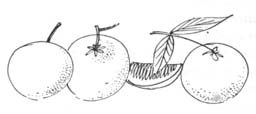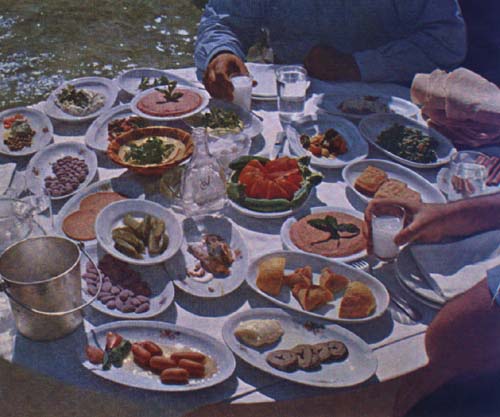
|
[Contents]INTRODUCTIONTHE full grace of Arab hospitality has been developed in Lebanon, where the traders of the known world have been welcomed since the earliest times. So fortunately situated at the eastern end of the Mediterranean, this country found early prosperity as the link between overland caravan routes from the East and the sailing ships and galleys of the West. Today, as for centuries, Lebanon plays host to the people and commerce of the world. It is proud of its importance to tourists and businessmen alike, with the result that its hotels and restaurants satisfy the demands of travellers as well as discerning residents. Good food is plentiful in Lebanon and its skilful cooks are masters of the intricacies of Arab cuisine. Because of the country's long and continuous contact with travellers, Lebanese hospitality has become quite articulate and it illustrates Arab customs in a manner easily understood by foreigners.

An Arab will offer his guest the best food and comfort that he can afford, often denying himself in deference to his guest. Following this tradition the Lebanese woman takes great pride in her home and seeks to make it the center of family living and social life. To create an attractive and inviting home she must be a good cook. She learns the art of cooking from her mother, adapting the traditional recipes to her modern needs. She has learned to simplify some of the old recipes so that she will be able to prepare the food her family likes and at the same time give part of her day to other activities. Lebanese hospitality leans heavily on the necessity that an abundant table should be set at all times. A hostess has food on hand to offer a guest no matter at what time of day or night he may arrive. She will urge her guests to eat heartily of the wide variety of foods which she has preparedfor their enjoyrnent. There is an Arabic proverb to the effect that the measure of a guest's regard for his host is the amount of food which he eats. * Coffee is essential to hospitality in Lebanon, as it is in all Middle Eastern countries. It is the traditional sign of welcome. Its price makes it a luxury and so its serving is a mark of respect for a visitor. Arabic (or Turkish) coffee cannot be reheated successfully because it must be freshly brewed to be good; so a guest is consciously flattered in the knowledge that he is being served a cup of coffee made expressly for him. The intricacies of the coffee ritual are explained later on in this book. Menus are carefully planned by Lebanese hostesses, tradition playing an important role in the selection of food for certain occasions. Many foods have significance in the Arab cultural pattern. These dishes are reserved for specific occasions. For instance, special sweets are prepared to celebrate the birth of a baby boy or to mark the cutting of a baby's first tooth. Special cakes called ma'moul are baked only at Easter or Christmas. The most famous of all Lebanese dishes, the rich pounded meat mixture called kibbeh (of which dozens of variations are possible) is served only at happy gatherings and would never be served after a funeral when a family is in mourning or at any farewell. The occasion also determines the amount of sugar added to Arabic coffee. Generally, the sweeter the coffee, the more joyous the occasion. A section of menus has been included in this book to illustrate how various dishes are combined on the table. The Lebanese kave some hard and fast rules about food. They will never serve their variant of yoghurt, laban, at the same meal with fish, nor will they mix laban and the taheeni sauce they prepare from sesame seed oil. Arabic cooking can be very economical. Very little food is wasted and ingenious uses are found for ingredients which might be discarded by less thrifty and less imaginative cooks. Western cooks who must coax interesting meals from mundane ingredients will hnd inspiration in Arab cooking for many variations of familiar themes. The wide selection of food evailable in Lebanon makes their diet the most varied of all Middle Eastern countries. The semitropical Mediterranean littoral produces excellent citrus fruits and bananas. The market gardens of the lower hillsides and valleys and the fields of the Bekaa' Valley yield a variety of cereals and vegetables all year around. The terraced orchards and vineyards of the mountains slopes produce apples, pears, peaches, grapes and many other fruits and berries. Additional fruits and vegetables are imported from nearby countries and Europe to further increase the variety available to Lebanese cooks. Such imported delicacies as avocados, Belgian endives, pineapples and coconuts appear with seasonal regularity. Beirut shops stock a wider selection of canned and packaged foods than one usually finds in most grocery shops in Europe and America. The fine lamb and mutton raised in the Middle East is the favorite meat of the people. It is plentiful and not as expensive as beef. Many kinds of fish are available to coastal dwellers. Milk from cows or goats is usually converted to laban (yoghurt), or made into the cream cheese, labneh. The main cereals are rice and cracked wheat, called burghul. Potatoes are consumed in quantity. The Arab cuisine depends to a great extent on oil. Food is cooked in it or dressed with it for serving. The choice of cooking fat often identifies the country from which the recipe originates. The Lebanese like to use their own fresh olive oil, or a clarified butter called samneh. The Turks use olive oil, vegetable shortening or butter, while in Saudi Arabia the preferred fat is ghee, usually obtained from goat or sheep milk. Olives, nuts, raisins, salted chick peas, toasted pumpkin seeds are always on hand as appetizers. Pickles made from turnips, beets, onions, green cauliflower and cucumbers are relished along with fresh greens. Bread is very important in the diet and its variations throughout the Middle East are explained in greater detail later on.
The Arabs like to spread their bread with olive oil, or with soft white cheese, or to dip it in the delicious oily purees which they make from chick peas, broiled eggplant or parsley flavored with pungent sesame seed oil. In the recipes, seasonings and ingredients remain authentic. Garlic may be omitted or decreased in quantity and vegetable shortening or butter may be substituted for the Arab shortening or fat. The amount of salt used in the recipes can be adjusted and is left to the discretion of the cook. Ingredients in this book are all given thelr local names. English equivalents of the "foreign words" are given in the glossary. In many recipes both the traditional and the revised pressure cooker methods are given so that the cook may make her own choice on how the dish will be prepared. All measurements are standard. The adjectives "minced ", "ground ", and "chopped " are used interchangeably with regard to meat. Welcome to the food of the Arab world, and eat heartily. Beirut, 1959 Marie Khayat and Margaret Keatinge
|

960118/980607
